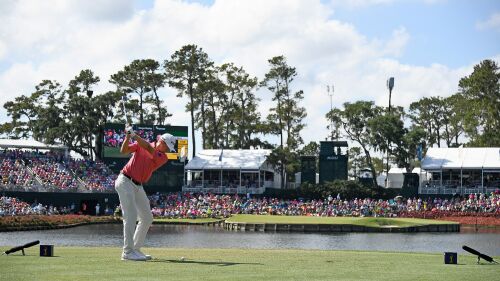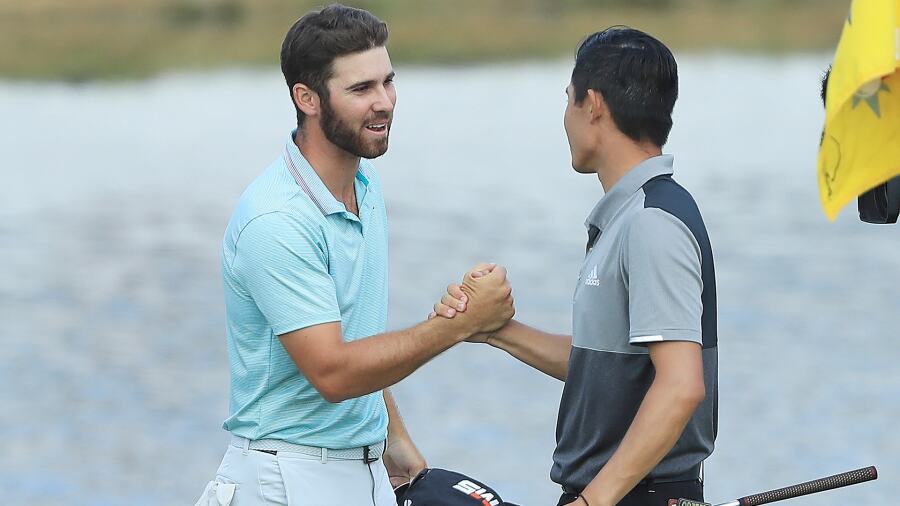It’s almost a rite of passage on the PGA Tour, the last spot in the Wednesday pro-am. Mid-afternoon tee time. Sparse to no crowd. A snail’s pace, yet a race to beat sunset.
“That’s the challenge for these young guys, trying to stay focused on days like this,” said caddie J.J. Jakovac as he walked down Bay Hill’s 16th fairway with daylight running out on the eve of the Arnold Palmer Invitational.
Just not for his guy.
A hole earlier, while waiting for a backup to clear on the next tee, Jakovac spent a few minutes dropping a tube of Chapstick on the green, the lip balm serving as a chipping target for 23-year-old Collin Morikawa, who had rolled a few balls down into the collection area right of the putting surface. Just two chips in, Morikawa’s ball struck the small tube with perfect speed.
That’s Morikawa, always learning.
The four-year Cal-Berkeley product has seamlessly become the poster child for the Tour’s latest youth movement, winning last summer at the Barracuda Championship, cracking the top 50 in the Official World Golf Ranking (even before peers and fellow Tour winners Matthew Wolff and Viktor Hovland) and rising to the top of the Tour’s consecutive-cuts-made list.
Since turning pro at last June’s RBC Canadian Open, Morikawa has played 21 straight weekends to begin his pro career. That’s better than Rory McIlroy, Justin Thomas and Jon Rahm, and just six shy of Mr. Hello World himself, Tiger Woods.
How has he done it? How has Morikawa so flawlessly and effortlessly – oh, and don’t forget emphatically (he’s got six other top-10s since graduating college) – introduced himself to the professional game?
“Have you seen him hit a golf ball?” exclaimed fellow Cal alum Max Homa. “He doesn’t miss.”
Morikawa certainly has God-given ball-striking abilities. He currently ranks fourth on Tour in strokes gained: approach (1.194), though he also has more measured rounds (35) than the three players in front of him – Rory McIlroy, Boo Weekley and Tyrrell Hatton – combined. Last week in gusty conditions on a treacherous Bay Hill layout, Morikawa led the field in that category, nearly a full stroke better than the second-place Hatton, who won the tournament.
Morikawa’s college coach, Walter Chun, tells a story of when Morikawa was testing equipment his senior year and was told by the fitter that Morikawa’s 6-iron dispersion matched that of a Tour pro’s pitching wedge.
“But if all it took was just hard work and hitting golf balls to get on the PGA Tour, there’d be a lot more guys on the PGA Tour,” Chun said. “There are so many intangible factors that go into it. … Collin has all of those intangibles.”
The most important of which can be found between the ears. Of all the players lined up weekly on a Tour range, Morikawa has few challengers as it relates to ball flight and even fewer when it comes to sheer brilliance (sorry, Bryson).
After all, Morikawa is the first Cal golfer to graduate from the prestigious Haas School of Business without needing a redshirt or taking summer school. He owns it like a badge of honor, too.
“Only one,” he says with a smile.
Just 13.5 percent of applicants get into Haas’ undergraduate program, a highly competitive environment where Morikawa-types thrive. Many Cal golfers have gone through the two-year curriculum, including Michael Weaver, Brandon Hagy and K.K. Limbhasut, but all of them opted to redshirt before applying in order to space out demanding pre-requisites such as economics and calculus. (Joel Stalter needed four years plus one semester of summer school to graduate from Haas.)
Morikawa, though, had other plans, telling Chun: Four years and I’m done.
“I saw a bunch of guys doing it in five [years],” Morikawa said. “Why not do it in four?”
The Players Championship: Full-field tee times | Full coverage
Morikawa doesn’t sugarcoat things; it wasn’t easy. During a particularly busy junior fall semester, he missed several practices and qualifiers. At regionals his senior year, he had two finals after the first round, for personal financial management and ethics in accounting. One of them was a written exam that took Morikawa about two-and-a-half hours.
“I was freaking out,” said Morikawa, who shot 74-73 to open the 54-hole event before closing in 67 to help the Bears advance to the NCAA Championship.
“Trying to play tournaments and knowing you’ve got a test when you get back home, it’s a grind,” said Tour rookie Scottie Scheffler, who earned a business degree while starring at Texas. “That stuff hangs in the back of your head. I remember coming home from tournaments and staying up all night writing a term paper.”
Yet Morikawa always delivered, in the classroom and on the course. Oh, especially on the course. In 48 career starts, Morikawa totaled five wins, 22 top-5s and 35 top-10s. He only finished outside of the top 20 three times. He is the school-record holder in scoring average (69.78) and is the only four-time All-American in school history.
“Only someone who is extremely talented at golf and very bright can do that,” Homa said. “I think both of them on their own would be pretty impressive.”
Homa knew Morikawa was special from the first time he saw him play, at the Wyoming Desert Intercollegiate in Palm Springs, California. Morikawa, then a junior at Cal, recorded just one bogey in 54 holes and shared medalist honors.
“He hit it as good as anybody I’d ever seen,” Homa said.
Jakovac knew just a few weeks into the job. Then came the final round in Reno, Nevada, when Morikawa birdied each of his last three holes to capture his first Tour title. The clutch finish was sparked by his tee shot at the par-3 16th, a high-cut 6-iron against the wind that landed 10 feet from the hole.
“If he doesn’t cut that ball and just hits a straight 6-iron, it’s out of bounds to the left,” Jakovac said. “He landed it exactly on our number.”
Chun has known for years. When he first stepped on campus, Morikawa instantly showed a burning desire to get better, working tirelessly on his putting and short game, even if he didn’t miss many greens. He also displayed a relentless thirst for information. Chun calls it Morikawa’s “encyclopedia of knowledge.”
“He doesn’t like not knowing things,” Chun said. “He likes to know more. He always wants to know what the next step is. He doesn’t want to brush things off to chance.”
And like an encyclopedia, Morikawa is constantly adding volumes, such as when he picked Jon Rahm’s brain at the Hogan Award Banquet in 2018. Rahm told Morikawa that staying at Arizona State for four years was the best decision he ever made, as it gave him time, especially that last semester, to prepare for the next level.
While continuing to test himself against the best amateurs in the world, Morikawa meticulously combed through management and endorsement options like he does everything else in his life – his phone apps are organized alphabetically and by purpose, he folds his clothes a particular way and he never eats at a restaurant without first consulting dozens of Yelp reviews. When he finally took the next step, he was unquestionably ready.
“You look at the best guys out here, they’re contending every single week, and it’s just ease and comfort level that they can go out and play any course, any single week, and play well,” Morikawa said. “I wouldn’t say I’m there yet because you put me in that college scenario, I played every course for three, four years, and I was always one of the guys to beat.
“That’s the sense I want to get out here. Mentally, I’m almost there.”
Morikawa is still in his first year as a professional. He has played just two courses twice: Silverado Resort and Spa, where he missed the cut in the 2016 Safeway Open before tying for 10th last fall, and Bay Hill, where he tied for ninth last week after sharing 64th in 2018. Perhaps that’s the “photographic memory” Chun also talks about in action.
Already a top-50 player in the world and arguably on the cusp of completely shedding his star-in-the-making label, what happens when Morikawa starts getting second and third looks at these Tour layouts?
“I said he was going to be one of the best players in the world pretty quickly,” Homa said. “He’s proving me right.”







